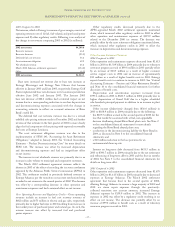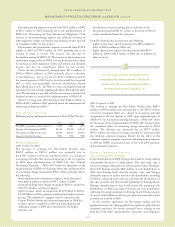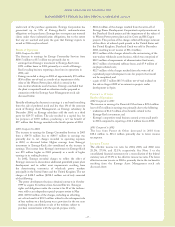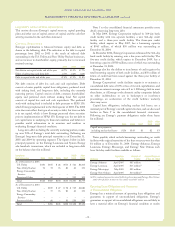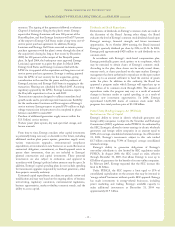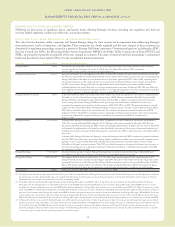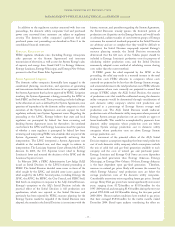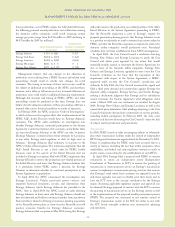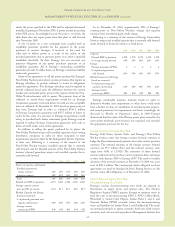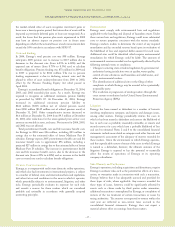Entergy 2004 Annual Report Download - page 37
Download and view the complete annual report
Please find page 37 of the 2004 Entergy annual report below. You can navigate through the pages in the report by either clicking on the pages listed below, or by using the keyword search tool below to find specific information within the annual report.
Entergy Corporation and Subsidiaries 2004
-35 -
In addition to the regulatory scrutiny connected with base rate
proceedings, the domestic utility companies’ fuel and purchased
power costs recovered from customers are subject to regulatory
scrutiny. The domestic utility companies’ significant fuel and
purchased power cost proceedings are described in Note 2 to the
consolidated financial statements.
Federal Regulation
FERC regulates wholesale rates (including Entergy intrasystem
sales pursuant to the System Agreement) and interstate
transmission of electricity, as well as rates for System Energy’s sales
of capacity and energy from Grand Gulf 1 to Entergy Arkansas,
Entergy Louisiana, Entergy Mississippi, and Entergy New Orleans
pursuant to the Unit Power Sales Agreement.
System Agreement Litigation
The domestic utility companies historically have engaged in the
coordinated planning, construction, and operation of generating
and transmission facilities under the terms of an agreement called
the System Agreement that has been approved by FERC. Litigation
involving the System Agreement is being pursued by the LPSC at
both FERC and before itself. These proceedings include challenges
to the allocationof costs as defined by the System Agreement, raise
questions of imprudence by the domestic utility companies in their
execution of the System Agreement, and seek support for local
regulatoryauthorityover System Agreement issues. Regarding the
proceeding at the LPSC, Entergy believes that state and local
regulators arepreempted by federal law fromreviewing and
deciding System Agreement issues for themselves. An unrelated
case between the LPSC and Entergy Louisiana raised the question
of whether a state regulator is preempted by federal law from
reviewing and interpreting FERC rate schedules that are part of the
System Agreement, and from subsequently enforcing that
interpretation. The LPSC interpreted a System Agreement rate
schedule in the unrelated case, and then sought to enforce its
interpretation. The Louisiana Supreme Court affirmed the LPSC’s
decision. In 2003, the U.S. Supreme Court ruled in Entergy
Louisiana’sfavor and reversed the decisions of the LPSC and the
Louisiana Supreme Court.
In February 2004, a FERC Administrative Law Judge (ALJ)
issued an Initial Decisionin the LPSC-initiated proceeding at
FERC. The Initial Decision decided some issues in favor of the
relief sought by the LPSC, and decided some issues against the
relief sought by the LPSC. Several parties, including Entergy, the
LPSC, the APSC, the MPSC, the City Council, and FERC Staff,
filed briefs onexceptions in response to the ALJ’s Initial Decision.
Entergy’sexceptions to the ALJ’sInitial Decisioninclude: the
practical effect of the Initial Decision is full production cost
equalization, whichwas rejected in the Initial Decision and
previouslyhas been rejected by FERC; resource planning for the
Entergy System would be impeded if the Initial Decision were
adopted; the remedy in the Initial Decisionis inconsistent with the
history, structure, and precedent regarding the System Agreement;
the Initial Decision’s remedy ignores the historical pattern of
production cost disparities on the Entergy System and would result
in substantial, sudden transfers of costs between groups of Entergy
customers; the numerical standards proposed in the Initial Decision
are arbitrary and are so complex that they would be difficult to
implement; the Initial Decision improperly rejected Entergy’s
resource planning remedy; the Initial Decision erroneously
determined that the full costs of the Vidalia project should be
included in Entergy Louisiana’s production costs for purposes of
calculating relative production costs; and the Initial Decision
erroneously adopted a new method of calculating reserve sharing
costs rather than the current method.
If FERC grants the relief requested by the LPSC in the
proceeding, the relief may result in a material increase in the total
production costs FERC allocates to companies whose costs
currently are projected to be less than the Entergy System average,
and a material decrease in the total production costs FERC allocates
to companies whose costs currently are projected to exceed that
average. If FERCadopts the ALJ’s Initial Decision, the amount
of production costs that would be reallocated among the domestic
utility companies would be determined through consideration of
eachdomestic utilitycompany’s relative total production cost
expressed as a percentage of Entergy System average total
production cost. The ALJ’s Initial Decision would reallocate
productioncosts of the domestic utilitycompanies whose percent of
Entergy System average production cost are outside an upper or
lower bandwidth. This would be accomplished by payments from
domestic utilitycompanies whose production costs are below
Entergy System average production cost to domestic utility
companies whose productioncosts areaboveEntergy System
average production cost.
Anassessment of the potential effects of the ALJ’s Initial
Decision requires assumptions regarding the future total production
cost of each domestic utility company, which assumptions include
the mix of solid fuel and gas-fired generation available to each
company and the costs of natural gas and purchased power.
Entergy Louisiana and EntergyGulf States are more dependent
upon gas-fired generation than Entergy Arkansas, Entergy
Mississippi, or Entergy New Orleans. Of these, Entergy Arkansas
is the least dependent upongas-fired generation. Therefore,
increases in natural gas prices likely will increase the amount by
whichEntergyArkansas’ total production costs are below the
average productioncosts of the domestic utilitycompanies.
Considerable uncertainty exists regarding future gas prices. Annual
average HenryHub gas prices have varied significantly over recent
years, ranging from$1.72/mmBtu to $5.85/mmBtu for the
1995-2004 period, and averaging $3.43/mmBtu during the ten-year
period 1995-2004 and $4.58/mmBtu during the five-year period
2000-2004. Recent market conditions have resulted in gas prices
that have averaged $5.85/mmBtu for the twelve months ended
December 2004. Based uponanalyses considering the effect on
MANAGEMENT’S FINANCIAL DISCUSSION and ANALYSIS continued


